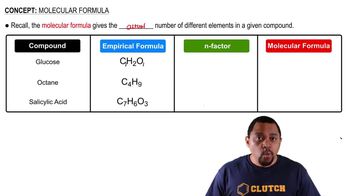Determine the empirical and molecular formulas of each of the following substances: (a) Styrene, a compound used to make Styrofoam® cups and insulation, contains 92.3% C and 7.7% H by mass and has a molar mass of 104 g/mol.
Determine the empirical and molecular formulas of each of the following substances: (a) Ibuprofen, a headache remedy, contains 75.69% C, 8.80% H, and 15.51% O by mass and has a molar mass of 206 g/mol.
 Verified step by step guidance
Verified step by step guidance
Verified video answer for a similar problem:
Key Concepts
Empirical Formula

Molecular Formula

Molar Mass

Determine the empirical and molecular formulas of each of the following substances: (b) Caffeine, a stimulant found in coffee, contains 49.5% C, 5.15% H, 28.9% N, and 16.5% O by mass and has a molar mass of 195 g/mol.
Determine the empirical and molecular formulas of each of the following substances: (c) Monosodium glutamate (MSG), a flavor enhancer in certain foods, contains 35.51% C, 4.77% H, 37.85% O, 8.29% N, and 13.60% Na, and has a molar mass of 169 g/mol.
Determine the empirical and molecular formulas of each of the following substances: (b) Cadaverine, a foul-smelling substance produced by the action of bacteria on meat, contains 58.55% C, 13.81% H, and 27.40% N by mass; its molar mass is 102.2 g/mol.
Determine the empirical and molecular formulas of each of the following substances: (c) Epinephrine (adrenaline), a hormone secreted into the bloodstream in times of danger or stress, contains 59.0% C, 7.1% H, 26.2% O, and 7.7% N by mass; its molar mass is about 180 u.
(a) Combustion analysis of toluene, a common organic solvent, gives 5.86 mg of CO2 and 1.37 mg of H2O. If the compound contains only carbon and hydrogen, what is its empirical formula?
